International Journal of Image, Graphics and Signal Processing @ijigsp
Статьи журнала - International Journal of Image, Graphics and Signal Processing
Все статьи: 1157
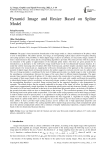
Pyramid Image and Resize Based on Spline Model
Статья научная
The paper is based around the formalization of the image model as a linear combination of B-splines, which is close to interpolation. The authors present, on average, its corresponding explicit aspects and low-frequency filtering and scaling operators. The possibility to obtain digital images scaled to an arbitrary, not necessarily integer, number of times is demonstrated in the article and the corresponding algorithm is provided. The article provides with the examples on estimation of the quality of approximation of the indicated spline model. Also there are given grounds for its introduction as an alternative to the well-known image model based on the two-dimensional Gaussian function. It is noted that with the increasing order, B-splines differ little from Gaussian, and their simpler calculation makes the spline model attractive for research and use. Applying the well-known formalization of the approach to the construction of a pyramid of digital images based on Gaussian functions, the authors suggest its extension onto the case of a spline model. The use of image pyramids is conditioned by the task of finding special points in a digital image in order to determine the unambiguous correspondence between the images of the same object in different digital photographs. The paper presents linear operators based on B-splines of 2-6 orders aimed at the construction of a pyramid, it also demonstrates an example of their usage. Based on the convolution of the raster with a mask with variable coefficients the possibility to obtain digital images scaled to an arbitrary, not necessarily integer, number of times is demonstrated in the article and the corresponding algorithm is provided. Image resizing based on the suggested algorithm is also demonstrated by examples. The authors believe that the research conducted in the paper in the future will allow for digital images to obtain more computationally simple algorithms for determining special points and their detectors. Results of paper: 1. The model of a DI has been formalized on the basis of two-dimensional polynomial splines, on the basis of B-splines of the second-sixth orders which are close to interpolation on the average. 2. The convolution operators of low-frequency DI filtering based on the spline model are presented. 3. Provided are the scaling operators used to build image pyramids, in order to further search for special points. 4. An algorithm for scaling the DI to an arbitrary, not necessarily an integer number of times based on a continuous spline approximation has been suggested. 5. Algorithm for scaling a digital image based on a spline model allows you to change the size of the image in any (not necessarily an integer) number of times, differs in that it provides high scaling accuracy and no artifacts due to high approximate properties and smoothness of the spline model;6. The scaling algorithm allows digital image processing at high computational speed due to the optimal computational scheme with a minimum of simpler mathematical operations, compared with models based on the two-dimensional Gaussian function.
Бесплатно
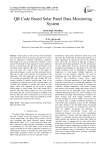
QR Code Based Solar Panel Data Monitoring System
Статья научная
Solar panels are safe and one of the commonly used renewable sources of energy generation now-a-days and are subjected to different atmospheric conditions. Data loggers are used to monitor the condition of solar panels with the help of data acquisition system. Zigbee is used as a transferring solar data from solar panels to the recording system (laptop). QR code is basically used to store and share any content, here in this paper an advanced technique is used to store the solar panel data in QR code in video form followed by developing a web application. This solar panel data can easily be accessed by scanning the generated QR code through QR code scanner installed in android mobile phone. One of the advantages of technique used in this research paper is to visualize the variations of graphs and values of data logger which were displayed on the screen of laptop during online in video format. This video format file is stored in QR code which reduces the size of pre-stored solar panel data file. Second advantage of technique used here that QR code allows reducing the size of pre-stored video format file of solar panel data monitoring system into image format without any loss of data.
Бесплатно
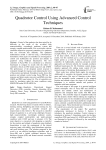
Quadrotor control using advanced control techniques
Статья научная
Control of the quadrotor has been noted for its difficulty as the result of the so-called high maneuverability, exceedingly nonlinear system and strongly coupled multivariable. This work deals with the simulation depend on proposed controllers of a quadrotor that can overcome this difficulty. The quadrotor mathematical model is derived using a Newton-Euler formulation. Three types of controllers are investigated to control and stabilization the position and attitude of quadrotor using feedback linearization. The first controller is Fuzzy-PID, it is considered as a reference benchmark to compare its results with the others two controllers which are PID tuned using GA and ANFIS. The performance of the designed control structure is evaluated through the response and minimizing the error of the position and attitude. Simulation results, shows that position and attitude control using Fuzzy-PID has fast response and better steady state error and RMS error than ANFIS and PID tuned using GA. The all controllers are tested by simulation under the same conditions using SIMULINK under MATLAB2015a.
Бесплатно
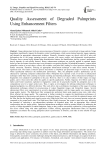
Quality Assessment of Degraded Palmprints Using Enhancement Filters
Статья научная
Image enhancement in the pre-processing stage of biometric systems is a crucial task in image analysis. Image degradation significantly impacts the biometric system’s performance, which occurs during biometric image capturing, and demands an appropriate enhancement technique. Generally, biometric images are mixed with full of noise and deformation due to the image capturing process, pressure with sensor surface, and photometric transformations. Therefore, these systems highly demand pure discriminative features for identification, and the system’s performance heavily depends on such quality features. Hence, enhancement techniques are typically applied in captured images before go into the feature extraction stage in any biometrics recognition pipeline. In palmprint biometrics, contact-based palmprints consist of several ridges, creases, skin wrinkles, and palm lines, leading to several spurious minutiae during feature extraction. Therefore, selecting an appropriate enhancement technique to make them smooth becomes a significant task. The feature extraction process necessitates a completely pre-processed image to locate key features, which significantly influences the identification performance. Thus, the palmprint system’s performance can be enhanced by exploiting competent enhancement filters. Palmprints have reported a lack of novelty in enhancement techniques rather than more centering on feature encoding and matching techniques. Some enhancement techniques in fingerprints were adopted for palmprints in the past. However, there is no clear evidence of their impact on image quality, and to what extent they affect the quality in specific applications. Further, frequency level filters such as the Gabor and Fourier transforms exploited in fingerprints would not be practically feasible for palmprints due to the computational cost for a larger surface area. Thus, it opens an investigation for utilising enhancement techniques in degraded palmprints in a different direction. This work delves into a preliminary investigation of the usage of existing enhancement techniques utilised for pre-processing of contact fingerprint images and biomedical images. Several enhancement filters were experimented on severely degraded palmprints, and the image quality was measured using image quality metrics. The High-boost filter comparatively performed better peak-signal-to-noise ratio, while other filters affected the image quality. The experiment is further extended to compare the identification performance of degraded palmprints in the presence and absence of enhanced images. The results reveal that the enhanced images with the filter that has the highest peak signal-to-noise ratio (High boost filter) only show an increased genuine accept rate compared to the ground truth value. The High-boost filter slightly decreases the system’s equal error rate, indicating the potential of exploiting a pre-enhancement technique on degraded prints with an appropriate filter without compromising the raw image quality. Optimised enhancement techniques could be another initiative for addressing the severity of image degradation in contact handprints. Doing so they could be successfully exploited in civilian applications like access control along with other applications. Further, utilising appropriate enhancement filters for degraded palmprints can enhance the existing palmprint system’s performance in forensics, and make it more reliable for legal outcomes.
Бесплатно
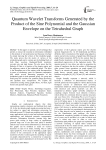
Статья научная
In this paper we present a novel technique that permits to extract the essential on information embedded in the product of sine polynomial and Gaussian envelope by simply knowing the vertices of the tetrahedral graph. The study proves that the matrix of vertices of the tetrahedral graph and its variants are the building block of both Haar wavelets, Hadamard-Walsh transform, wavelets sets and tight frames. We also prove that the Berkeley B Gate is a function of the degree matrix and the adjacency matrix of the tetrahedral graph. The latter is the Hermitian part of the unitary polar decomposition in terms of elementary gates for quantum computation [68] which reveals interesting properties of the tetrahedral graph in both quantum group, Lie group and Pauli group for wavelets sets, quantum image processing and quantum data compression. We explore the connection existing among graphs theory, wavelets, tight frames and quantum logic gates.
Бесплатно
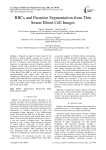
RBCs and Parasites Segmentation from Thin Smear Blood Cell Images
Статья научная
Manually examine the blood smear for the detection of malaria parasite consumes lot of time for trend pathologists. As the computational power increases, the role of automatic visual inspection becomes more important. An automated system is therefore needed to complete as much work as possible for the identification of malaria parasites. The given scheme based on used of RGB color space, G layer processing, and segmentation of Red Blood Cells (RBC) as well as cell parasites by auto-thresholding with offset value and use of morphological processing. The work compare with the manual results obtained from the pathology lab, based on total RBC count and cells parasite count. The designed system successfully detects malaria parasites and RBC cells in thin smear image.
Бесплатно
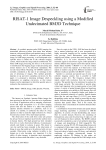
RISAT-1 Image Despeckling using a Modified Undecimated BM3D Technique
Статья научная
In synthetic aperture radar (SAR) imaging, the transmitted microwave pulses from space born antenna interacts with ground objects and returned energy or back scattered energy will be collected to get backscattered image. In SAR image processing, a not anticipated noise (speckle noise) is added due to the coherent imaging system, which makes the image analysis troublesome. For better SAR image processing, the noise is to be removed or minimized in the begging stages of pre-processing and texture features are to be effectively maintained. The wavelet based Block Matching 3D (BM3D) method is normally considered as the state of art technique in the area of denoising of images. This method generally depends on up and down sampling conversion. In this paper, it is proposed a denoising technique which is independent on sampling conversion, so that texture features can be maintained, in which the speckle noise is reduced to the maximum extent.
Бесплатно
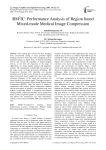
RM2IC: Performance Analysis of Region based Mixed-mode Medical Image Compression
Статья научная
The medical data science has been changing from conventional analog to more powerful digital imaging systems for some time. These imagining systems produced images in digital form. As digital technology evolves and exceeds the capability of analog imaging devices, so too does the expansion in the range of applications for image guided surgical and diagnostic systems. The optimization of bandwidth and storage are the major issues in image processing technology. The Compressive Sensing (CS) algorithm can become prominent tool for these issues because it can sample the signal with much lesser sample rate than twice of the maximum frequency of the signal and reconstruct the signal similar to the original signal. This paper, presents a novel scheme Region based Mixed-mode Medical Image Compression (RM2IC). Here, the region of interest is compressed with lossless hybrid compression methods and the non-region of interest is com-pressed with lossy hybrid CS algorithm. RM2IC is compared with different existing hybrid compression methods and it outperforms better visual perceptional quality of reconstructed image and reduces the compression rate. The performance analysis is done based on PSNR, MSE and compression ratio.
Бесплатно
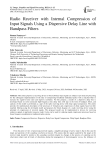
Статья научная
This article proposes a receiving device in which arbitrary input signals are subject to pre-detector processing for the subsequent implementation of the idea of compressing broadband modulated pulses with a matched filter to increase the signal-to-noise ratio and improve resolution. For this purpose, a model of a dispersive delay line is developed based on series-connected high-frequency time delay lines with taps in the form of bandpass filters, and analysis of this model is performed as a part of the radio receiving device with chirp signal compression. The article presents the mathematical description of the processes of formation and compression of chirp signals based on their matched filtering using the developed model and proposes the block diagram of a radio receiving device using the principle of compression of received signals. The proposed model can be implemented in devices for receiving unknown signals, in particular in passive radar. It also can be used for studying signal compression processes based on linear frequency modulation in traditional radar systems.
Бесплатно
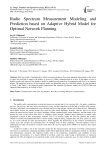
Статья научная
Path loss model is fundamental to effective network planning. It provides adequate information on the extent of signal loss and help to improve the quality of service of cellular communication in an area. In this paper we used a hybrid wavelet and improved log-distance model for modeling and prediction of propagation path loss in an irregular terrain. The prediction accuracy of the proposed model was quantified using five statistical metrics. As seen presented in Table 2 and Table 3, the proposed model outperformed the standard log-distance model, the COST234 Hata and Okumura Hata models by an average of 20%.
Бесплатно
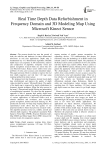
Статья научная
The present decade has seen the growth of both, the software and hardware for three dimensional televisions in real time applications. Depth map is fundamental key of 3-Dimensional algorithms. Reliable depth map is an acceptance in 3D transmission, analysis and compression of algorithm. Computer vision and pattern recognition research fields use sensor like low cost Microsoft kinect. Kinect sensor suffers from some problems of noise, poor accuracy and unmatched edges. This paper presents effective solution to improve the real time depth sequences and real time 3-D map using warping method from kinect sensor. We proposed real time frequency domain based depth data refurbishment and improve the quality of depth video provided by sensors' Microsoft Kinect. The quality of the depth map is improved by depth refurbishment in frequency domain technique, filling the holes present in the maps, 2-Dimensional spatial filtering and permutation of morphological operation. We show that the proposed approach is able to generate high quality depth maps which can be quite useful in improving the performance of various applications of Microsoft Kinect such as obstacle detection and avoidance, pose estimation, gesture recognition, skeletal and facial tracking, etc. We produce the real time 3-D map using warping method. An experimental result shows that the quality of our proposed method is better than previous research works. Our algorithm produces noise less, reliable, smooth and efficient depth sequence. The qualitative parameter Peak Signal to Noise Ratio (PSNR), Structure Similarity Index Map (SSIM) and Mean Square Error (MSE) measure the real time results for comparative analysis.
Бесплатно
Real Time Detection and Tracking of Human Face using Skin Color Segmentation and Region Properties
Статья научная
Real time faces detection and face tracking is one of the challenging problems in application like computer human interaction, video surveillance, biometrics etc. In this paper we are presenting an algorithm for real time face detection and tracking using skin color segmentation and region properties. First segmentation of skin regions from an image is done by using different color models. Skin regions are separated from the image by using thresholding. Then to decide whether these regions contain human face or not we used face features. Our procedure is based on skin color segmentation and human face features (knowledge-based approach). We have used RGB, YCbCr, and HSV color models for skin color segmentation. These color models with thresholds, help to remove non skin like pixel from an image. Each segmented skin regions are tested to know whether region is human face or not, by using human face features based on knowledge of geometrical properties of human face.
Бесплатно
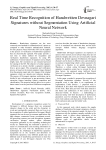
Статья научная
Handwritten signatures are the most commonly used method for authentication of a person as compared to other biometric authentication methods. For this purpose Neural Networks (NN) can be applied in the process of verification of handwritten signatures that are electronically captured. This paper presents a real time or online method for recognition and verification handwritten signatures by using NN architecture. Various features of signature such as height, length, slant, Hu's moments etc are extracted and used for training of the NN. The objective of online signature verification is to decide, whether a signature originates from a given signer. This recognition and verification process is based on the instant signature image obtained from the genuine signer and a few images of the original signatures which are already part reference database. The process of Devnagari signature verification can be divided it into sub-processes as pre-processing, feature extraction, feature matching, feature comparison and classification. This stepwise analysis allows us to gain a better control over the precision of different components
Бесплатно
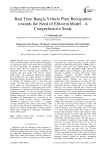
Статья научная
Bangla vehicle number plate recognition is still an unsolved research issue for efficient investigation of unregistered vehicles, traffic observation, management and most importantly for Intelligent Transportation System (ITS). Previous research on vehicle plate recognition have been suffering various challenges, i.e. capturing high level image from moving vehicles, number plate with complicated background, detection from different tilt and angle, detection in different lightening conditions and weather conditions, recognition of doubtful and ambiguous signs in road time road scenario. The main aim of this research is to provide critical analysis on various perspectives of vehicle plate recognition, i.e. Extraction of vehicle plates from vehicle, Segmentation of characters and finally, Recognition of segmented characters. At first, this research illustrates comprehensive reviews on existing methods. After that, existing frameworks are analyzed based on overall advantages and disadvantages for each steps in the previous research. Finally, extensive experimental validation is depicted in five aspects, i.e. method, accuracy, processing time, datasets and relevancy with real time scenario. Proposed comprehensive reviews are expected to contribute significantly to perform efficient vehicle plate recognition in Intelligent Transportation System (ITS) research.
Бесплатно
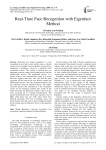
Real-Time Face Recognition with Eigenface Method
Статья научная
Real-time face image recognition is a face recognition system that is done directly using a webcam camera from a computer. Face recognition system aims to implement a biometrics system as a real-time facial recognition system. This system is divided into two important processes, namely the training process and the identification process. The registration process is a process where a user registered their name in a system and then registers their face. Face data that has been registered will be used for the next process, namely the identification process. The face registration process uses face detection using the OpenCV library. The feature extraction process and introduction to the recognition system use the Eigenface method. The results of this study found that, the Eigenface method is able to detect faces accurately up to 4 people simultaneously. The greater the threshold value will result in a greater value of FRR, while there isn’t any FAR value found from different thresholds. The level of lighting, poses, and facial distance from the camera when training and testing the face image heavily influences the use of the eigenface method.
Бесплатно
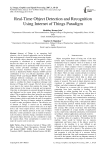
Real-Time Object Detection and Recognition Using Internet of Things Paradigm
Статья научная
Internet of Things is an emerging field wherein a lot of classical approaches can be inculcated. One such approach is found in image processing domain. It is real-time object detection and recognition. Object recognition is considered as a complicated process because the object can be of any shape, size or color. Object detection can be performed with effectiveness by using various prevalent techniques such as Scale Invariant Feature Transform (SIFT), a faster version known as Speeded-Up Robust Features (SURF) and the combination of two very efficient algorithms called as Oriented FAST and Rotated BRIEF (ORB) and so on. Although different techniques are dedicated to the different type of objects. In this paper, an effort has been made to combine the object recognition technique with Internet of Things (IoT) concept. The IoT device acting as an input is the camera that captures the image. The object present in the image is detected and recognized. After that, its information is extracted through the internet and displayed on the screen along with the recognized object. The recognition takes place using the pre-existing database. The database consists of the objects that have salient features which would make the task of recognition unambiguous. The bag of features method is considered in order to make recognition effective. The effective use of Internet of Things is carried out by establishing communication between a camera which acts as an input device and visual output devices. This communication takes place over Internet protocol. In the case of object detection, various parameters such as rotation invariance, scale invariance, intensity change, orientation invariance and partial object detection are also considered to make the system robust. Time consideration is carried out to make the system work in real time.
Бесплатно
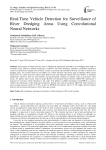
Статья научная
The presence of illegal activities such as illegitimate mining and sand theft in river dredging areas leads to economic losses. However, manual monitoring is expensive and time-consuming. Therefore, automated surveillance systems are preferred to mitigate such activities, as they are accurate and available at all times. In order to monitor river dredging areas, two essential steps for surveillance are vehicle detection and license plate recognition. Most current frameworks for vehicle detection employ plain feed-forward Convolutional Neural Networks (CNNs) as backbone architectures. However, these are scale-sensitive and cannot handle variations in vehicles' scales in consecutive video frames. To address these issues, Scale Invariant Hybrid Convolutional Neural Network (SIH-CNN) architecture is proposed for real-time vehicle detection in this study. The publicly available benchmark UA-DETRAC is used to validate the performance of the proposed architecture. Results show that the proposed SIH-CNN model achieved a mean average precision (mAP) of 77.76% on the UA-DETRAC benchmark, which is 3.94% higher than the baseline detector with real-time performance of 48.4 frames per seconds.
Бесплатно
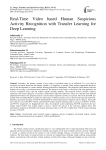
Real-Time Video based Human Suspicious Activity Recognition with Transfer Learning for Deep Learning
Статья научная
Nowadays, the primary concern of any society is providing safety to an individual. It is very hard to recognize the human behaviour and identify whether it is suspicious or normal. Deep learning approaches paved the way for the development of various machine learning and artificial intelligence. The proposed system detects real-time human activity using a convolutional neural network. The objective of the study is to develop a real-time application for Activity recognition using with and without transfer learning methods. The proposed system considers criminal, suspicious and normal categories of activities. Differentiate suspicious behaviour videos are collected from different peoples(men/women). This proposed system is used to detect suspicious activities of a person. The novel 2D-CNN, pre-trained VGG-16 and ResNet50 is trained on video frames of human activities such as normal and suspicious behaviour. Similarly, the transfer learning in VGG16 and ResNet50 is trained using human suspicious activity datasets. The results show that the novel 2D-CNN, VGG16, and ResNet50 without transfer learning achieve accuracy of 98.96%, 97.84%, and 99.03%, respectively. In Kaggle/real-time video, the proposed system employing 2D-CNN outperforms the pre-trained model VGG16. The trained model is used to classify the activity in the real-time captured video. The performance obtained on ResNet50 with transfer learning accuracy of 99.18% is higher than VGG16 transfer learning accuracy of 98.36%.
Бесплатно
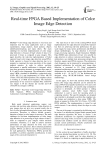
Real-time FPGA Based Implementation of Color Image Edge Detection
Статья научная
Color Image edge detection is very basic and important step for many applications such as image segmentation, image analysis, facial analysis, objects identifications/tracking and many others. The main challenge for real-time implementation of color image edge detection is because of high volume of data to be processed (3 times as compared to gray images). This paper describes the real-time implementation of Sobel operator based color image edge detection using FPGA. Sobel operator is chosen for edge detection due to its property to counteract the noise sensitivity of the simple gradient operator. In order to achieve real-time performance, a parallel architecture is designed, which uses three processing elements to compute edge maps of R, G, and B color components. The architecture is coded using VHDL, simulated in ModelSim, synthesized using Xilinx ISE 10.1 and implemented on Xilinx ML510 (Virtex-5 FX130T) FPGA platform. The complete system is working at 27 MHz clock frequency. The measured performance of our system for standard PAL (720x576) size images is 50 fps (frames per second) and CIF (352x288) size images is 200 fps.
Бесплатно
Real-time Object Tracking with Active PTZ Camera using Hardware Acceleration Approach
Статья научная
This paper presents the design and implementation of a dedicated hardware (VLSI) architecture for real-time object tracking. In order to realize the complete system, the designed VLSI architecture has been integrated with different input/output video interfaces. These video interfaces along with the designed object tracking VLSI architecture have been coded using VHDL, simulated using ModelSim, and synthesized using Xilinx ISE tool chain. A working prototype of complete object tracking system has been implemented on Xilinx ML510 (Virtex-5 FX130T) FPGA board. The implemented system is capable of tracking the moving target object in real-time in PAL (720x576) resolution live video stream directly coming from the camera. Additionally, the implemented system also provides the real-time desired camera movement to follow the tracked object over a larger area.
Бесплатно

